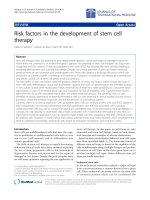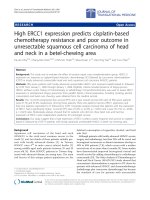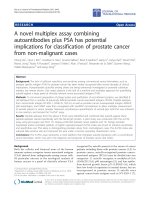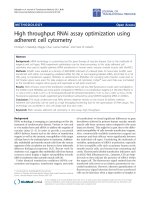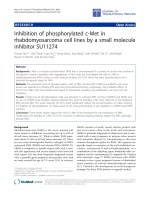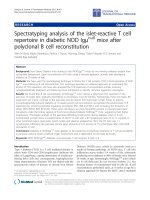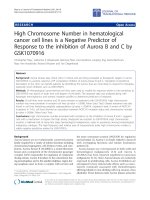Báo cáo sinh học: "High throughput RNAi assay optimization using adherent cell cytometry" pot
Bạn đang xem bản rút gọn của tài liệu. Xem và tải ngay bản đầy đủ của tài liệu tại đây (1.4 MB, 9 trang )
METH O D O LOG Y Open Access
High throughput RNAi assay optimization using
adherent cell cytometry
Christoph S Nabzdyk, Maggie Chun, Leena Pradhan
*
and Frank W LoGerfo
Abstract
Background: siRNA technology is a promising tool for gene therapy of vascular disease. Due to the multitude of
reagents and cell types, RNAi experiment optimization can be time-consuming. In this study adherent cell
cytometry was used to rapidly optimize siRNA transfection in human aortic vascular smooth muscle cells (AoSMC).
Methods: AoSMC were seeded at a density of 3000-8000 cells/well of a 96well plate. 24 hours later AoSMC were
transfected with either non-targeting unlabeled siRNA (50 nM), or non-targeting labeled siRNA, siGLO Red (5 or 50
nM) using no transfection reagent, HiPerfect or Lipofectamine RNAiMax. For counting cells, Hoechst nuclei stain or
Cell Tracker green were used. For data analysis an adherent cell cytometer, Celigo
®
was used. Data was normalized
to the transfection reagent alone group and expressed as red pixel count/cell.
Results: Aft er 24 hours, none of the transfection conditions led to cell loss. Red fluorescence counts were normalized to
the AoSMC count. RNAiMax was more potent compared to HiPerfect or no transfection reagent at 5 nM siGLO Red (4.12
+/-1.04 vs. 0.70 +/-0.26 vs. 0.15 +/-0.13 red pixel/cell) and 50 nM siGLO Red (6.49 +/-1.81 vs. 2.52 +/-0.67 vs. 0.34 +/-0.19).
Fluorescence expression results supported gene knockdown achieved by using MARCKS targeting siRNA in AoSMCs.
Conclusion: This study underscores that RNAi delivery depends heavily on the choice of delivery method.
Adherent cell cytometry can be used as a high throughput-screening tool for the optimization of RNAi assays. This
technology can accelerate in vitro cell assays and thus save costs.
Keywords: RNAi vascular, adherent cell cytometry, in vitro assay, high throughput
Background
RNAi technolo gy is emerging as a promising tool for the
treatment of cardiovascular disease. Various in vitro and
in vivo studies have used siRNA to address the sequelae of
vascular injury [1-3]. In order to provide a successful
siRNA delivery, factors such as the choice of transfection
reagent as well as the intrinsic susceptibility of the target
cell type have to be evaluated prior to treatment. Addition-
ally, endothelial and smooth muscle cells from the various
segments of the circulation are known to have inherently
different biological properties [4,5]. Recent work by
Andersen et al. suggests that endothelial cells from human
coronary artery display a higher susceptibility towards
siRNA transfection than smooth muscle cells [6].
Under identical transfection conditions (siRNA con-
centration and sequen ce, transfection rea gent, and mode
of transfection) we found significant differences in gene
knockdown ac hieved in primary human vascular smooth
muscle cells from coronary artery co mpared to the aorta
(data not shown). This might be in part due to the differ-
ential susceptibility of cells towards transfection reagents.
Also, commercially available transfection rea gents are
numerous and their efficacy varies significantly between
the individual cell types. C onsidering the multitude of
variables, optimization of siRNA transfection, especially
in less susceptible cells such as primary human aortic
smooth muscle cells, can become time consuming and
costly. Fluorescently labeled transfection indicators such
as siGLO Red (Dharmacon Inc., Lafayette, CO) are help-
ful tools as they indicate the presence of siRNA within
the target cell. The fluorescence signal emitted from the
transfected cells serves as an indirect parameter for suc-
cessful transfection. However, objective quantification of
fluorescence signal intensity derived from transfected
cell s can be laborious when a large number of sampl es is
* Correspondence:
Division of Vascular and Endovascular Surgery, Beth Israel Deac oness Medical
Center, Harvard Medical School, Boston, MA, USA
Nabzdyk et al. Journal of Translational Medicine 2011, 9 :48
/>© 2011 Nabzdyk et al; licensee BioMed Central Ltd. This is an Open Access article dist ributed under the terms of the Creative
Commons Attribution License ( , which permi ts unrestricted use, distribution, and
reproduction in any mediu m, provided the original work is properly cited.
analyzed using either flow cytometry or manual analysis
of fluorescent pixel counts. In addition, flow cytometry
analysis of vascular smooth muscle cells or other stromal
cells is more difficult to perform compared to e.g., lym-
phocytes, due to the heterogeneous shape of stromal cells
and the tendency to aggregate and clump.
Therefore it is desirable to have a system that provides a
rapid high-through-put analysis of fluorescence expression
in transfected c ells to guide the transfection strategy. In
the present study, the adherent cell cytometry system
Celigo
®
(Cyntellect Inc., San Diego, CA) was used; a
bench top in situ system that rapidly generated whole well
images and instant fluorescence based a nalysis. Ideally,
this system would allow multiple cross comparisons
between the different treatment conditions. F urther, the
availability of such a system might reduce the dependence
on Q-RT-PCR and flow cytometry for the optimization of
siRNA assays and thereby help reduce time and costs.
Methods
For a detailed list of reagents and equipment used see
Additional File 1.
Cell Culture
Human Aortic Smooth Muscle Cells (Lonza, Walkers-
ville, MD) were cultured in basal medium (LifeLine,
Walkersville, MD) enriched with the supplied SMC
growth additives. The media was m aintained in a humi-
dified incubator at 37°C with 5% CO2. Cells from pas-
sages 6 - 9 were used in the experiments.
siRNA/siGLO Red transfection
Confluent AoSMCs were seeded at a density of 3000-
8000 cells/well in a BD Falcon 96-well black-bottom
plate (Fisher, Pittsburg, PA). 24 hours later, cells were
transfected with either non-targeting unlabeled siRNA
(50 nM) (CAT#ID D-001206-13-20, Dharmacon, Lafay-
ette, CO), siRNA targeting human MARCKS (CAT#ID
D-004772-04, Dharmacon, Lafayette, CO) or siGLO
Red (5 or 50 nM) (Dharmacon, Lafayette, CO) using
no transfection reagent, HiPerfect (Qiagen, Valencia,
CA), or Lipofectamine RNAi Max (Invitrogen, Carls-
bad, CA) as recommended by the manufacturer. A
master mix was created for each individual conditio n
in order to eliminate pipetting errors and to increase
consistency between each well. The experimental set-
up of the twelve conditions for each cell type is out-
lined i n Figure 1.
Plate analysis with the adherent cell cytometry system
Celigo
®
The system used in this study allows quantification of
cellular responses in formats ranging from 1536- to 6-
well plates and T-25 and T-75 flasks, both at full
resolution of 1 mm/pixel as well as half-resolut ion (2 ×
2 binning). The working aperture of the scan lens is
9 mm, and the system enables very rapid imaging by
using fast galvanometer mirrors to scan and stitch mul-
tiple fields-of-view into a full resolution image, requiring
far fewer mechanical stage movements and focus opera-
tions as comp ared with conventional micro scopes. This
design enables imaging of the entire well, including
ever y cell in every well in the analysis. Image segmenta-
tion capabilities allow for customized analysis and a
real-time gating i nterface to enable subpopulations of
cells to be defined/quantified based on simple or c om-
plex phenotypes. Multi-p arameter analysis can be based
on morphology features (e.g. cell area, shape, etc.) and/
or functional readouts (e.g. fluorescence expression mar-
kers, reporters).
Figure 1 Experimental conditions and total number of samples.
Human aortic smooth muscle cells were transfected in the presence
or absence of a transfection reagent (HiPerfect™ or RNAiMax™;
0.375 μl/100 μl each). Each group was further divided into four
conditions: no siRNA, 50 nM unlabeled control siRNA, and 5 nM and
50 nM of siGLO Red transfection indicator. Each treatment was
carried out in quadruplicates and each experiment was repeated
three times for a total sample size of 144.
Nabzdyk et al. Journal of Translational Medicine 2011, 9 :48
/>Page 2 of 9
Prior to plating, cells were stained with Cell Tracker
Green (Invitrogen) and with Hoechst nuclei stain
(2.6 μg/m L, Invitrogen). Plates were read using the
adh erent cell cytometer equipped with a brightfield and
three fluorescent channels: a blue filter for the Hoechst
nuclei stains, red filter for the siGLO Red, and green for
the Cell Tracker Green cytoplasmic dye.
Gating parameters were adjusted for each fluorescence
channel to exclude background and other non-specific
signals. The Celigo
®
system provided a gross quantita-
tive analysis for each fluorescence channel, including
total counts of gated events.
RNA extraction and Q-RT-PCR
RNA was extracted and cDNA was generated using the
Cells-to-CT™ Kit (Ambion, Foster City, CA). Q-RT-
PCR was performed using Power Sybr Green Mastermix
(Ambion, Foster City, CA) and a Stratagene™Mx3000p
Q-RT-PCR system (Stratagene, La Jolla, CA) (PCR pri-
mers in Table 1). Gene knockdown was calculated using
the ΔΔ-Ct method.
Statistical Analysis
At least three independent experiments were performed
and results were analyzed using Graph Pad Prism Ver-
sion 5.0 software (Graph Pad Software Inc, La Jolla,
CA). For expression analysis, two-way ANOVA with
Bonferroni post-hoc analysis was used to assess statisti-
cal significance. For Q-RT-PCR analysis, one-way
ANOVA with Bonferroni post-hoc analysis was per-
formed. A ‘p’ value of less than 0.05 was considered as
statistically significant.
Results
Cell count and cytotoxicity of transfection reagents
Fluorescence expression analysis and cell counts were
obtained. The Celigo
®
system allows basic assessment of
size and morphology of live adherent cells based on
brightfield contrast differences between the cell mem-
brane, cytosol, and extracellular space. However, at
higher cell densities and due to the complex geometry
of AoSMCs, it was diff icult to obtain exact cell counts
using the Celigo
®
’s brightfield cell segmentation func-
tion (Figure 2A & 2B). In order to address this issue,
AoSMCs were trypsinized and manually counted using a
hemocytometer prior to plating. AoSMCs were then
seeded at known densities into 96-well plates, allowed
to attach, and then counted by automated fluorescence
exp ression analysis using Hoechst nuclear stain and the
system’s gating function. A strong cell count correlation
was observed between the two methods with r
2
=
0.9856 (Figure 2C).
Subsequently, cell counts based on H oechst nuclear
stain were compared side by side with counts based on
a cytoplasmic stain (Cell Tracker Green, Molecular
Probes) (Figure 2D-E). Both approaches allowed for
reliable and c omparable cell counts with a strong cor-
relation between the two methods with r
2
= 0.9493
(Figure 2F).
In order to quantify cytotoxicity of our treatments, cell
counts post-siRNA/siGLO Red transfections were
assessed. No significant cell loss was observed 24 h after
transfection in any of the treatment groups irrespective
of the choice of transfection reagent or siRNA or siGLO
Red concentration (p > 0.05) (Figure 2G).
Transfection differences between transfection reagents in
human primary aortic smooth muscle cells
Celigo
®
software was u sed to generate representative
scatter plots that depict red fluorescence area (in μm
2
)
and fluorescence integrated intensity (sum of the pixel
intensities within a gated event) of the gated events in
the individual treatment groups within a single well of
the 96-well plate (Figure 3).
Minimal background fluorescence was detected in
AoSMCs treated with 50 nM unlabeled control siRNA
(no transfection reagent) as depicted in Figure 3A.
Strong differences were seen in total count, fluorescence
area size, and integrated intensity of red fluorescence
signals in AoSMCs treated with 5 nM or 50 nM siGLO
Red depending on the transfection reagent (5 nM data
not shown, Figure 3B-D). The presence of either HiPer-
fect or RNAiMax drastically increased the transfection
success compared to ‘no transfection reagent’.Further,
50 nM siGLO Red combined with RNAiMax showed
higher transfection rates compared to HiPerfect.
Visualization of the transfected cells confirmed that
the vast majority of red fluorescence originated from
siGLO Red transfected AoSMCs with only minimal
extracellular signals (Figure 4A-I). In addition, the
adherent cell cytometer precisely detected the nuclei
and fluorescently labeled siGLO Red siRNA within the
AoSMCs (Figure 4J and 4K).
Next we n ormalized the t otal red f luorescence pixel
count (not accounting for fluorescence intensity or area)
per well to the cell count in the individual well in order
to control for variations in cell seeding densities. Subse-
quently, the fraction of recorded red fluorescence pixel
divided by the nuclei number was termed ‘red pixel per
cell’ or ‘red pixel/nucleus.’
Table 1 List of Q-RT-PCR primers
Primer ID Sequence 5’-3’
MARCKS forward CGGCAGAGTAAAAGAGCAAGC
MARCKS reverse GGTTGTAGACAAGTTCTCCAAAAC
B2M forward CTCCACAGGTAGCTCTAGGAG
B2M reverse TCTGACCAAGATGTTGATGTTGG
Nabzdyk et al. Journal of Translational Medicine 2011, 9 :48
/>Page 3 of 9
Background fluorescence was negligible in all unla-
beled control gro ups (no siRNA and 50 nM unlabeled
control siRNA) and no significant differences were
detected between the individual groups irrespective of
the transfection reagent (Figure 5).
In the fluorescent labeled siGLO Red treated cells, all
transfection reagent groups showed a dose dependent
increase (5 nM and 50 nM siGLO Red) in fluorescence
signal count per cell compared to unlabeled control
groups (Figure 5).
Interestingly, there was no difference in fluorescence
pixel count/cell when AoSMCs were treated with 5 nM
siGLO Red and HiPerfect compared to AoSMCs trans-
fected with 5 nM siGLO Red and no transfection
reagent. Significant differences were observed only when
50 nM siGLO Red and HiPerfect were used when com-
pared to no transfection reagent.
However, when AoSMCs were treated with RNAiMAX
and siGLO Red, fluorescence pixel counts/cell were signif-
icantly higher compared to AoSMCs transfected with
siGLO Red using either HiPerfect or no transfection
reagent. This was observed in AoSMCs transfected with 5
nM siGLO Red (RNAiMax vs. HiPerfect vs. no transfec-
tion reagent; 4.12 +/-1.04 vs. 0.70 +/-0.26 vs. 0.15 +/-0.13
Figure 2 Cell counts of live adherent human AoSMCs in cell culture using Celigo
®
cytometer. (A) Overlay of AoSMC brightfield and DAPI
filter images (Hoechst nuclei stain, blue). (B) Segmentation of AoSMCs seen in (A) and their nuclei. For the detection specific gating parameters
were adjusted for the Celigo
®
cytometer. Although suboptimal brightfield segmentation (light blue borders) was observed when gating the
individual AoSMCs, the Celigo
®
system segmented the nuclei (purple borders) accurately due to their homogenous shape and strong
fluorescence signal and thus provided a precise total cell count. (C) Correlation between cell counts obtained by a hemocytometer and the
Celigo
®
cell count based on Hoechst nuclei stain. (D) AoSMCs dual labeled with Hoechst nuclei stain and cytoplasmic dye Cell Tracker Green.
(E) Overlay of fluorescence channels with gated nuclei (white line) and cytoplasm border (light blue line) overlapping. (F) Individual stain counts
(blue, DAPI filter and green, FITC filter) compared in dual labeled cells with Hoechst nuclei stain (blue) and the cytoplasmic dye Cell Tracker
Green (green). (G) AoSMC counts were not significantly different between the individual treatment conditions.
Nabzdyk et al. Journal of Translational Medicine 2011, 9 :48
/>Page 4 of 9
Figure 3 Scatter plots of control siRNA or siGLO Red transfected AoSMCs using different transfection reagents. Composition of scatter
plot diagrams generated with Celigo
®
system software. Parameters depicted are fluorescence area (x-axis) and integrated fluorescence intensity
(y-axis). (A) 50 nM unlabeled control siRNA, no transfection reagent group. The area boxed in yellow represents the majority of red signal
fluorescence (background fluorescence) in this group. (B) 50 nM siGLO Red, no transfection reagent group. The yellow highlighted area from (A)
serves as a comparison. (C)50 nM siGLO Red with HiPerfect group. Boxed area of (A) compared to the gated events recorded in (C). (D) 50 nM
siGLO Red with RNAiMax group. Area of (A) compared to gated events recorded in AoSMCs transfected with 50 nM siGLO Red complexed with
RNAiMax transfection reagent.
Nabzdyk et al. Journal of Translational Medicine 2011, 9 :48
/>Page 5 of 9
red pixel/cell, respectively) as well as in the 50 nM siGLO
Red groups (6.49 +/-1.81 vs. 2.52 +/-0.67 vs. 0.34 +/-0.19
red pixel/cell, respectively).
In order to correlate fluorescence expression findings
with actual gene silencing, AoSMCs were transfected
with siRNA targeting the gene MARCKS. The MARCKS
siRNA protocol had been established prior to this study
in our lab [6]. Levels of g ene knockdown were analyzed
using Q-RT-PCR. With the exception of exchanging
siGLO Red with MARCKS siRNA, identical transfection
conditions were used as in the adherent cytometer
experiments. Q-RT-PCR data supported siGLO Red
transfection experiments. MARCKS siRNA in the
absence of a transfection reagent or complexed with
HiPerfectdidnotleadtoasignificantMARCKSgene
knockdown compared to control (Figure 6A and 6B).
Only 50 nM MARCKS siRNA complexed with RNAi-
Max led to a significant reduction of MARCKS mRNA
levels by 60% compared to controls (Figure 6C). In
accordance with the Q-RT-PCR results, 50 nM siGLO
Red complexed with RNAiMax provided significantly
higher transfection rates (red fluorescence pixel/per cell)
than any other transfection condition.
Discussion
RNAi technology is a powerful and promising new tool
in the field of gene therapy.
However, in order to achieve the highest possible bio-
logical e ffect, several aspects of siRNA delivery must be
addressed and adapted to the individual experimental
model.
Given the vast amount of cell lines and primary cells
available, combined with the long list of transfection
reagents, it can be time consuming and expensive to iden-
tify the optimal transfection conditions for the experiment.
Fluorescence-based transfection indicators such as siGLO
Figure 4 Comparison of transfection reagents in siGLO Red transfected AoSMCs. (A, D, and G) No transfection reagent with 50 nM
control siRNA, 5 nM siGLO Red and 50 nM siGLO Red respectively. (B, E, and H) HiPerfect transfection reagent (0.375 μl/100 μl) with 50 nM
control siRNA, 5 nM siGLO Red and 50 nM siGLO Red respectively. (C, F, and I) RNAiMax transfection reagent (0.375 μl/100 μl) with 50 nM
control siRNA, 5 nM siGLO Red and 50 nM siGLO Red respectively. (J) Representativepicture of 50 nM siGLO Red + RNAiMax transfected AoSMCs
used for quantification. AoSMCs were also stained with Hoechst nuclei stain. Both fluorescent signals were confined within the cells. (K)
Represents Figure 4J with the gated fluorescent events (red dots/circles = siGLO Red; blue circles = Hoechst stained nuclei). Note the exact
overlay of actual and detected fluorescent events. The vast majority of gated signals originated from the AoSMCs.
Nabzdyk et al. Journal of Translational Medicine 2011, 9 :48
/>Page 6 of 9
Red are helpful guides. However, quantification of fluores-
cence intensity is labor intensive if performed manually
using imaging software. Alternatively, flow cytometry sys-
tems require large cell numbers and hence increase experi-
men tal costs . Additionally, primary stromal cells such as
AoSMCs are difficult to transfe ct and anal yze using flow
cytometry. Therefore it is desirable to establish an assay
that allows for a high throughput analysis of adherent cells
based on fluorescence expression. Our data demonstrate
that adherent cell cytometry provides ample opportunities
to customize c ellular assays in vitro and can help accele rate
experimental optimization in a high throughput fashion e.
g. in the setting of siRNA transfection. Due to the design
of the adherent cytometry systems, cell numbers and
reagent volumes can be minimized compared to flow cyto-
metry, reducing experimental costs and allowing for multi-
ple replicates and various comparisons on an individual
plate.
In this exemplary study, the efficacy of two commer-
cially available transfection reagents (HiPerfect, RNAi-
Max) in combination with two different concentrations
of siGLO Red transfection indicator (5 and 50 nM) or
50 nM unlabeled control siRNA was examined.
Transfection success was measured by the number of
red fluorescent signals representing the transfection
indicator siGLO Red within the AoSMCs. This count
was then norma lized to the cell count in the analyzed
well. We analyzed AoSMCs after transfection with either
‘ no siRNA, ’‘50 nM unlabeled control siRNA,’‘5nM
siGLO red,’ or ‘50 nM siGLO red’ using either ‘no trans-
fection reagent,’‘HiPerfect,’ or ‘RNAiMax.’
Results showed that the Celigo
®
system can be conve-
niently and accurately used to count live cells based on
the two live cell dyes, Hoechst or Cell tracker green,
with a strong correlation between the two methods.
Neither siRNA nor siGLO Red treatment led t o cell
loss 24 h post-transfection. Only minimal fluorescence
signals were observed in the ‘ no transfection reagent’
group even when using a high siGLO Red concentra-
tion. Presence of HiPerfect and RNAiMax increased rate
of transfection compared to no transfection reagent
when combined with 5 and 50 nM siGLO Red. RNAi-
Max provided a highe r rate of transfection compared to
HiPerfect both at 5 nM (0.70 versus 4.12 red pixels/cell,
respectively) and 50 nM siGLO Red (2.52 versus 6.49
red pixels/cell, respectively). These findings helped our
research as we identified RNAiMax as the more potent
transfection reagent of the two, a relevant finding for
our subsequent experiments. Importantly, fluorescence
expression results were supported by the matching Q-
RT-PCR data from experiments in which the gene
MARCKS was silenced. Q-RT-PCR data revealed that
only 50 nM MARCKS siRNA (in place of siGLO Red)
complexed with RNAiMax led to a significant reduction
of MARCKS mRNA levels of 60% in AoSMCs w hile all
other conditions did not. According to the adherent cyt-
ometer data, successful siGLO Red transfections were
also achieved when transfecting AoSMCs w ith siGLO
Red (5 and 50 nM) complexed with HiPerfect and 5 nM
siGLO Red with RNAiMax. However, these f indings
were not exactly mirrored in the corresponding Q-RT-
PCR experiments.
This could be due to the necessity of a critical le vel of
intracellular siRNA in order to facilitate significant gene
silencing. Other explanations could be that some of the
detected siGLO Red was attached to the outside o f the
cell or trapped within the cell membrane and thus did
not enter the RISC complex. Further, once siRNA enters
the cell it has to escape the endosome (’endo-lysosomal
escape’) in order to hybridize with the target mRNA. It
is possible that some of the detected intrac ellular siGLO
Red was trapped within an endo-lysosome and therefore
also prevented it from entering the RISC complex.
Given the discussed biological barriers that the siRNAs
need to overcome, it is not surprising that a significant
gene knockdown only occurred at higher transfection
rates (red pixel/cell). In our expe rimen ts this threshold
Figure 5 Comparison of siGLO Red counts per cell in dif ferent
treatment conditions. (A) Comparison of siGLO Red pixel counts/
cell among different siRNA treatment conditions in AoSMCs that
have been transfected without transfection reagent, or with
HiPerfect, or RNAiMax. (B) Transposition of (A). Comparison of siGLO
Red pixel count/cell among different transfection reagents in
AoSMCs that have either not been transfected or were transfected
with 50 nM control siRNA, 5 nM siGLO Red or 50 nM siGLO Red.
Nabzdyk et al. Journal of Translational Medicine 2011, 9 :48
/>Page 7 of 9
was surpassed onl y in the 50 nM MARCKS siRNA and
RNAiMax treatment group. Taken together our data
suggest that adherent cell cytometry is a very sensitive
method that can detect spurious amounts of fluores-
cently labeled siRNA localized on the outside or within
the target cells.
More importantly, the analysis of an individual experi-
ment with 48 samples in a 96-well plate using the
Celigo
®
system only took about 30 minute s. This analy-
sis consisted of cell count and fluorescence expression
analysis (total counts, area, mean, and in tegra ted fluor-
escence intensity). It is safe to assume that it would
have taken a much longer time to obtain the same cell
count using either a hemocytometer or an automated
cell counter. Colorimetric assay such as the Alamar Blue
assay, although commonly used to assess proliferation
and cytotoxicity, is not very sensitive and cell counts
obtained from this assay are affected by the metabolic
state of the cells tested.
Our data show that adherent cell cytometry is a versa-
tile technology that can be used to analyze customized
assays such as fluorescence-based cell function assays,
either at one specific time point or over repeated time
points. In fact, results could also be obtai ned from fixed
and immunofluorescence labeled cells. With the avail-
ability of three fluorescence channels in the adherent
cell cytometer, one channel can be used to detect the
fluorescently labeled siRNA and the other two can be
used to identify the effects of intracellular siRNA on cel-
lular functions using live cell fluorescence reporter
assa ys. For example, this set-up could be used to screen
siRNA libraries to identify the siRNA sequence that
exerts the strongest effects on cell proliferation or apop-
tosis. Another benefit of the system is the simultaneous
assessment of various cell functions within live adherent
cells without interrupting cell-cell contacts. The bench-
top format of this technology may significantly acce ler-
ate in vitro experiments involving adherent ce lls for
non-industry related laboratories.
Conclusion
Adherent cytometry is a versatile technology that can be
used to monitor proliferation, cell death and other cell
functions in live cells. In this study we demonstrated
that adherent cell cytometry is a simple method to
detect fluorescently labeled siRNA in target cells. Based
on fluorescence indicator expression analysis our results
suggest that there are significant differences in the effi-
cacy of the transfection r eagents H iPerfect and RNAi-
Max, with RNAiMax showing higher transfection rates
in human AoSMCs. Matching Q-RT-PCR data support
these findings. Taken together, our data suggest that
adherent cell cytometry can be used as a high through-
put-screening tool for the optimizatio n of RNAi assays.
This technology can accelerate various in vitro cell
assays and thus save time and costs.
Additional material
Additional file 1: List of reagents and equipment. Comprehensive list
of reagents and equipment used for the described experiments
including catalogue numbers.
Figure 6 MARCKS silencing in AoSMCs.(A)Notransfection
reagent was used. No significant knockdown was achieved using 5
nM or 50 nM MARCKS compared to no reagent control. (B)
Transfection reagent HiPerfect combined with 5 nM or 50 nM
MARCKS siRNA did not result in significant MARCKS gene
knockdown compared to control groups. (C) RNAiMax combined
with 50 nM MARCKS siRNA resulted in a significant reduction of
MARCKS mRNA levels compared to control groups.
Nabzdyk et al. Journal of Translational Medicine 2011, 9 :48
/>Page 8 of 9
Acknowledgements
NIH R01HL021796-26 to FWL
NIH R01HL086741-04 to FWL
Authors’ contributions
CSN - Experimental design, data acquisition and analysis, editing of the
manuscript. MC - Data acquisition, editing of the manu script. LP -
Experimental design, manuscript review. FWL - Experimental design,
manuscript review. All authors read and approved the final manuscript.
Competing interests
The authors declare that the y have no competing interests.
Received: 14 February 2011 Accepted: 25 April 2011
Published: 25 April 2011
References
1. Wang L, Zheng J, Bai X, Liu B, Liu CJ, Xu Q, Zhu Y, Wang N, Kong W,
Wang X: ADAMTS-7 mediates vascular smooth muscle cell migration and
neointima formation in balloon-injured rat arteries. Circ Res 2009,
104:688-698.
2. Hlawaty H, San Juan A, Jacob MP, Vranckx R, Letourneur D, Feldman LJ:
Local matrix metalloproteinase 2 gene knockdown in balloon-injured
rabbit carotid arteries using nonviral-small interfering RNA transfection. J
Gene Med 2009, 11:92-99.
3. Monahan TS, Andersen ND, Martin MC, Malek JY, Shrikhande GV, Pradhan L,
Ferran C, LoGerfo FW: MARCKS silencing differentially affects human
vascular smooth muscle and endothelial cell phenotypes to inhibit
neointimal hyperplasia in saphenous vein. FASEB J 2009, 23:557-564.
4. Majesky MW: Developmental basis of vascular smooth muscle diversity.
Arterioscler Thromb Vasc Biol 2007, 27:1248-1258.
5. Aird WC: Phenotypic heterogeneity of the endothelium: II.
Representative vascular beds. Circ Res 2007, 100:174-190.
6. Andersen ND, Monahan TS, Malek JY, Jain M, Daniel S, Caron LD, Pradhan L,
Ferran C, Logerfo FW: Comparison of gene silencing in human vascular
cells using small interfering RNAs. J Am Coll Surg 2007, 204:399-408.
doi:10.1186/1479-5876-9-48
Cite this article as: Nabzdyk et al.: High throughput RNAi assay
optimization using adherent cell cytometry. Journal of Translational
Medicine 2011 9:48.
Submit your next manuscript to BioMed Central
and take full advantage of:
• Convenient online submission
• Thorough peer review
• No space constraints or color figure charges
• Immediate publication on acceptance
• Inclusion in PubMed, CAS, Scopus and Google Scholar
• Research which is freely available for redistribution
Submit your manuscript at
www.biomedcentral.com/submit
Nabzdyk et al. Journal of Translational Medicine 2011, 9 :48
/>Page 9 of 9



